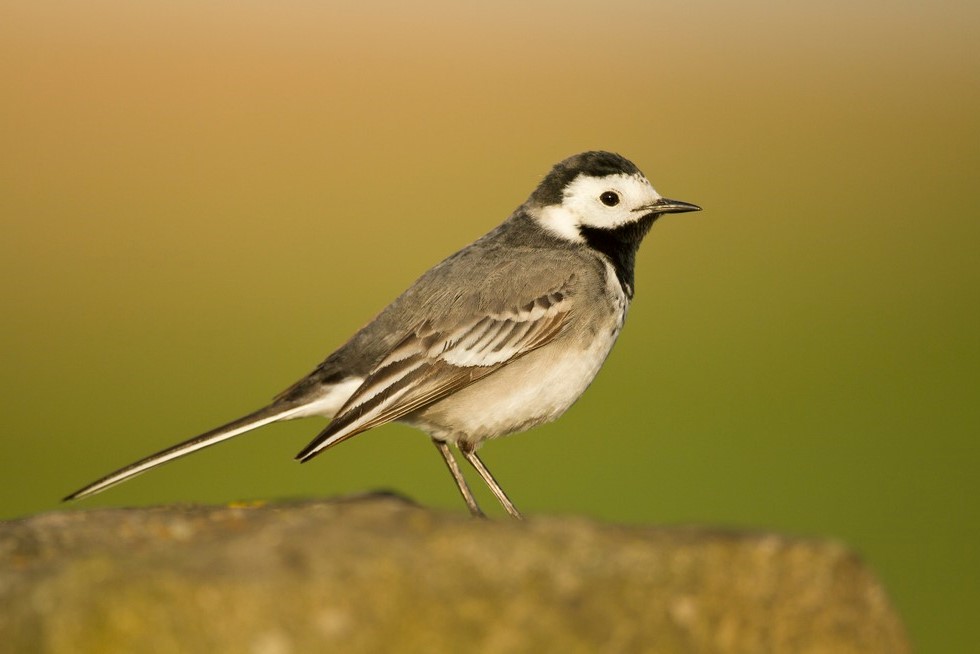The Pied Wagtail (Motacilla alba), also known as the White Wagtail, is a charismatic and widespread passerine bird species that belongs to the family Motacillidae. Renowned for its lively, animated tail wagging, this small bird can be found across various habitats in Europe, Asia, and parts of North Africa. With its distinctive black and white plumage, graceful flight, and delightful foraging behaviour, the Pied Wagtail has captured the attention and admiration of bird enthusiasts and casual observers alike.
Physical Description and Behaviour
The Pied Wagtail measures around 17-19 centimetres in length, with a wingspan of approximately 25 centimetres. The adult male displays a black head, throat, and upper breast, contrasting with a white face, underparts, and lower breast. Its back and wings are also black, while the outer tail feathers exhibit a striking pattern of white, forming the wagging feature that gives the bird its name. Female Pied Wagtails possess similar plumage, but with slightly duller colours.
One of the most endearing traits of the Pied Wagtail is its energetic and distinctive tail movements, which it performs while walking or foraging. This behaviour serves multiple purposes, including communication within the species, territorial displays, and attracting potential mates. The wagtail’s slender body and long, slender tail give it a graceful appearance in flight, accompanied by agile aerial manoeuvres.

Habitat and Distribution
Pied Wagtails are highly adaptable birds, capable of thriving in a variety of habitats, including urban areas, wetlands, meadows, parks, and gardens. They are commonly found near water bodies such as rivers, streams, ponds, and lakes, where they can easily access their primary food sources—small invertebrates, including insects, spiders, and aquatic invertebrates. Their versatile nature has enabled them to colonise a wide range of environments across their distribution range.
These charming birds have a vast distribution range, extending from western Europe to eastern Asia. They can be spotted in countries such as the United Kingdom, France, Germany, Russia, China, Japan, and India, among others. During the breeding season, they tend to occupy regions with suitable nesting sites and abundant food sources. In colder climates, they migrate southward during winter, seeking warmer regions for survival.
Breeding and Life Cycle
Pied Wagtails typically breed between April and July, forming monogamous pairs. They construct their nests in a variety of locations, including crevices in walls, rooftops, bridges, and tree hollows. The nests are made of grass, twigs, moss, and other fine materials, providing a secure environment for the eggs and hatchlings.
The female wagtail lays a clutch of 4-6 eggs, which she incubates for about two weeks. During this period, the male actively defends the territory and assists in food gathering for the female. Once the eggs hatch, both parents partake in feeding the chicks, regurgitating insects and larvae to meet their growing appetites. After approximately two weeks, the fledglings leave the nest, although they continue to rely on their parents for food and protection for a few more weeks.

Conservation Status and Threats
The Pied Wagtail is considered a species of least concern by the International Union for Conservation of Nature (IUCN) due to its large and stable population. Its adaptability to diverse habitats and its ability to thrive in urban areas have contributed to its relatively healthy numbers.
However, certain factors pose threats to the species. Urbanisation, habitat loss, and pollution impact the availability of suitable nesting sites and food sources for Pied Wagtails. Pesticides and insecticides can reduce the availability of insects, which form a vital part of their diet. Climate change and the alteration of water bodies also affect their habitats and may disrupt their migratory patterns.
Conservation efforts should focus on preserving wetland habitats, ensuring the availability of nesting sites, and promoting sustainable land management practices. By raising awareness about the importance of maintaining biodiversity and protecting the environment, we can contribute to the long-term survival of this delightful avian species.
Conclusion
The Pied Wagtail (Motacilla alba) is a captivating bird that enchants with its striking plumage, lively tail wagging, and nimble flight. Its adaptability to various habitats and its ability to coexist with human activities have allowed it to thrive across its vast distribution range. By appreciating and protecting the habitats this species depends on, we can ensure the continued presence of this charming avian wonder.
As we observe the playful wagging of its tail and witness its acrobatic foraging techniques, we are reminded of the beauty and diversity of the natural world. The Pied Wagtail serves as a reminder that even small birds can leave a significant impact and bring joy to those who take the time to appreciate them. Let us cherish and safeguard the habitats they call home, ensuring that future generations can delight in the presence of these charismatic creatures.
Additional Resources
Sources and References
- “Birds of Britain and Europe” by Roger Peterson, Guy Mountfort, and P. A. D. Hollom.
- “The Complete Book of British Birds” by Rob Hume.
Sam loves to learn about animals and their habitats. He has been a nature lover from a very young age, and has been writing papers and articles about wildlife for as long as he can remember.
